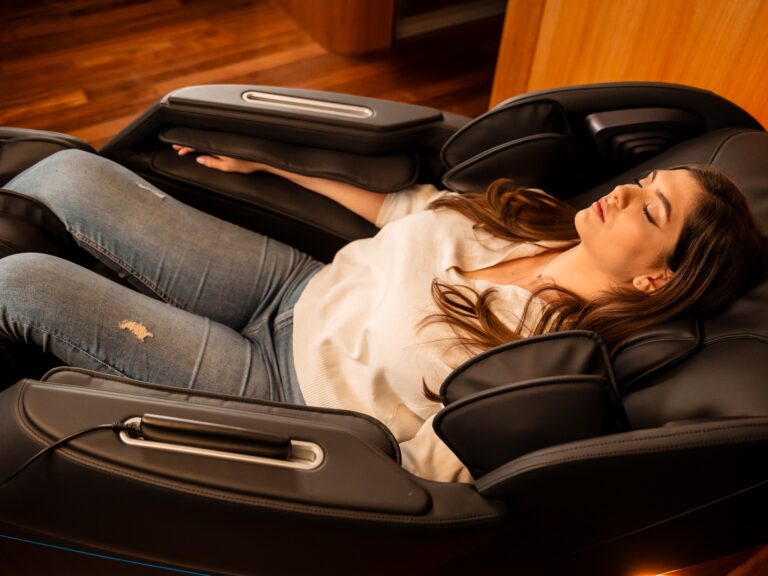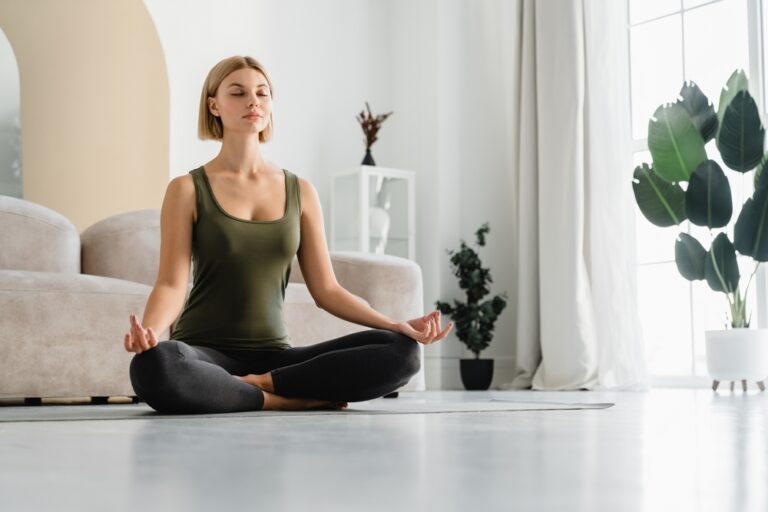To effectively use props in Yin Yoga for enhanced relaxation, practitioners should thoughtfully incorporate items such as bolsters, blocks, and straps.
Bolsters offer cushioning and support during extended holds, facilitating comprehensive body relaxation and comfort. Blocks aid in maintaining proper alignment and can elevate the body, alleviating strain on the joints. Straps assist in preserving correct posture, making various stretches more accessible.
It is essential to tailor the use of props to meet individual needs, adjusting their height and arrangement for optimal comfort. Additionally, cultivating a serene environment can significantly enhance the experience, encouraging the exploration of relaxation techniques that deepen one’s practice.
Furthermore, consider experimenting with different props to discover what works best for you. For instance, using a folded blanket under the knees in poses like Supta Baddha Konasana can provide extra support.
Also, incorporating eye pillows during savasana can promote deeper relaxation by blocking out light. Engaging in mindful breathing while using props can deepen the sense of tranquility and connection to the body.
Ultimately, the thoughtful integration of props can transform your Yin Yoga practice into a profoundly restorative experience.
Understanding Yin Yoga Principles
While many yoga styles emphasize movement and flow, Yin Yoga invites practitioners to investigate stillness and introspection. At its essence, the Yin Yoga philosophy centers around the concepts of surrender and acceptance, encouraging individuals to connect more deeply with their own bodies and emotional landscapes. Unlike more dynamic practices, Yin Yoga focuses on passive stretching, targeting the connective tissues, joints, and fascia, which often hold tension and stress.
Incorporating mindfulness practices into Yin Yoga boosts the experience, allowing practitioners to cultivate a heightened awareness of their thoughts and sensations. This mindfulness aspect encourages participants to observe rather than react, creating a safe space for self-discovery and healing. Within each pose, practitioners are invited to remain still for extended periods, typically ranging from three to five minutes, which fosters patience and encourages a deeper exploration of both physical and mental states.
Furthermore, the principles of Yin Yoga extend beyond the mat, promoting a philosophy of compassion and service toward others. Practitioners often find that the qualities developed through their practice—such as empathy, presence, and adaptability—translate into their interactions in everyday life. Through embracing the principles of Yin Yoga, individuals not only boost their physical well-being but also cultivate a mindset that prioritizes mindfulness and connection, ultimately benefiting those around them. This comprehensive approach encourages a sense of community and support, making Yin Yoga an enriching practice for both the individual and their broader environment.
Importance of Props in Yin Yoga
In Yin Yoga, props play an essential role in enhancing comfort and support during poses, allowing practitioners to hold stretches for extended periods without strain. Through providing extra support, these tools promote safe alignment, ensuring that the body can relax deeply while minimizing the risk of injury. Ultimately, the effective use of props not only enriches the practice but also helps individuals investigate their body’s limits mindfully.
Enhancing Comfort and Support
Props play a crucial role in improving comfort and support during Yin Yoga practice. Through utilizing different props, practitioners can adapt poses to suit their individual needs, ensuring a more relaxed and enjoyable experience. Effective prop selection strategies involve understanding the specific requirements of each pose and the unique body types of participants. For instance, using bolsters under the knees or blankets for support can alleviate pressure, allowing for deeper relaxation and a longer hold in each position.
Moreover, incorporating props improves the sensory experience, making it more accessible and enjoyable. When students feel more comfortable, they can focus on their breath and the meditative aspects of the practice, rather than their discomfort. Furthermore, props such as blocks or straps can help create stability, enabling practitioners to settle into poses without straining.
Promoting Safe Alignment
Using props in Yin Yoga is essential for promoting safe alignment during practice. When practitioners utilize tools like bolsters, blocks, and straps, they can achieve safe positioning in different poses, allowing their bodies to relax deeply without undue strain. This safe positioning not only improves the complete experience but also reduces the risk of injury, particularly for those new to Yin Yoga or with existing physical limitations.
Mindful adjustments with props empower instructors to guide students effectively. By providing proper support, instructors can help practitioners maintain alignment in postures that may otherwise be challenging. For instance, a bolster under the knees in a seated forward bend can alleviate pressure on the lower back, creating a more comfortable and sustainable stretch. Moreover, using blocks in a supported bridge pose can facilitate a gentle opening of the chest and shoulders.
Ultimately, the incorporation of props fosters an environment where practitioners can examine their limits while prioritizing safety. This approach not only nurtures the physical body but also encourages a deeper connection to the self, promoting a comprehensive practice that aligns with the principles of Yin Yoga.
Common Props Used in Practice
In Yin Yoga, practitioners often rely on several common props to improve their experience and support their bodies during long-held poses. Vital items like bolsters, blocks, and straps serve specific functions, such as providing comfort, stability, and alignment, which can greatly deepen the practice. Understanding the benefits of each prop not only aids in achieving proper form but also fosters a greater sense of relaxation and mindfulness throughout the session.
Essential Props Overview
While many practitioners might overlook the importance of props in Yin Yoga, they play a crucial role in improving comfort and deepening relaxation during poses. Understanding prop selection strategies is indispensable for instructors and practitioners alike, as the right props can facilitate a more profound experience in each posture. Common props include bolsters, blankets, blocks, and straps, each serving a unique purpose in supporting the body.
Bolsters provide cushioning and can be used under the back or legs to encourage the body to relax fully. Blankets offer extra support and warmth, making them ideal for creating a comfortable space. Blocks can help modify poses, ensuring that practitioners can achieve proper alignment without strain. Straps assist in extending reach, helping individuals maintain ease in certain stretches.
When considering effective prop combinations, one might pair a bolster with a blanket or use blocks alongside straps to improve stability and comfort. Through thoughtfully incorporating these props into practice, instructors can guide others towards greater relaxation, ensuring a nurturing environment that promotes healing and tranquility. Understanding these crucial props is a foundational step toward fostering a more enriching Yin Yoga experience.
Benefits of Each Prop
Many practitioners find that understanding the benefits of each prop greatly boosts their Yin Yoga experience. Each supportive prop serves a specific purpose, improving relaxation and promoting a deeper connection to the body. For instance, bolsters provide alignment assistance during poses, allowing for restorative practice and encouraging mindful breathing. These props also facilitate emotional release, helping students process feelings that arise during deep stretching.
Similarly, blankets offer versatility, providing warmth and comfort, while blocks assist in achieving proper alignment, reducing the risk of injury. Through utilizing these props, practitioners increase body awareness, enabling them to listen to their bodies more effectively. Straps can improve flexibility, allowing individuals to deepen their stretches without straining.
The careful amalgamation of these supportive props fosters an environment conducive to improved relaxation and tranquility. By prioritizing comfort and safety, practitioners can focus on their breath and the present moment, further enriching their practice. As a result, the thoughtful use of props not only aids in injury prevention but also transforms a regular Yin Yoga session into a profound restorative experience, inviting a more fulfilling adventure for all involved.
How to Use Yoga Blocks
Yoga blocks serve as invaluable tools for practitioners looking to deepen their practice and improve their alignment. Through utilizing block variations and exploring block positioning, yogis can create a supportive foundation that improves their experience in Yin Yoga. These blocks are versatile and can be adjusted to suit individual needs, making them crucial for all levels of practice.
To effectively use yoga blocks, practitioners can consider the following techniques:
- Under the hips: Placing a block beneath the hips in seated poses can alleviate strain and promote better posture.
- Support for forward bends: A block can be positioned under the forehead or hands in forward bends, allowing for a more relaxed stretch without overextending the spine.
- Improving backbends: Using a block behind the back during gentle backbends helps maintain the natural curve of the spine while providing support.
- Lifting the ground closer: When reaching for the floor feels challenging, a block can raise the hands, allowing for a more comfortable and supported stretch.
- Creating stability in balance poses: Positioning blocks under the feet in standing poses provides stability and encourages proper alignment.
Incorporating Bolsters for Support
Bolsters offer an excellent way to improve comfort and support in Yin Yoga, complementing the use of yoga blocks. When practitioners incorporate bolsters into their practice, they can experience numerous bolster benefits, including increased relaxation and the ability to hold poses for extended periods. This supportive prop helps create a sense of safety and ease, allowing individuals to surrender into each posture.
Proper bolster positioning is fundamental for maximizing its effectiveness. Placing a bolster under the knees during a seated forward bend can relieve pressure on the lower back while positioning it beneath the back during a supported fish pose encourages gentle heart opening. Through strategically using bolsters, practitioners can adjust their practice to meet their unique needs, promoting deeper relaxation and restorative benefits.
For those guiding others in their Yin Yoga experience, understanding how to suggest bolster placement is significant. Encouraging students to experiment with different positions can help them find what feels best for their bodies. Reminding them that the goal of Yin Yoga is to cultivate stillness, it’s crucial to guarantee that they feel fully supported throughout their practice.
As students become more attuned to using bolsters, they may uncover new ways to deepen their experience, enabling them to remain in poses longer without strain. Through integrating bolsters thoughtfully, both instructors and practitioners can elevate their understanding of Yin Yoga, fostering a nurturing environment that promotes healing and relaxation.
Utilizing Straps for Alignment
When practicing Yin Yoga, utilizing straps can greatly boost alignment and deepen the experience in different poses. Straps serve as an invaluable tool for practitioners seeking to improve their practice while promoting safety and comfort. Through incorporating alignment techniques with straps, individuals can achieve a more profound sense of connection with their bodies, encouraging relaxation and mindfulness.
Here are several strap benefits to reflect on during a Yin Yoga session:
- Improved Posture: Straps can help maintain proper alignment by guiding the body into an ideal position.
- Increased Flexibility: With the assistance of straps, practitioners can gently stretch muscles that might otherwise remain tight.
- Augmented Stability: Straps provide support, allowing individuals to hold poses for more extended periods without strain.
- Better Focus: By ensuring alignment, straps help shift focus away from discomfort, allowing for deeper meditative states.
- Accessibility: Straps enable individuals of all flexibility levels to access poses, making Yin Yoga more inclusive.
When using straps, it’s crucial to adjust the tension according to one’s comfort level, ensuring that the straps support rather than restrict movement. Practitioners should also be mindful of how the straps influence their alignment, making subtle adjustments as needed. Through embracing these alignment techniques, individuals can cultivate a more enriching experience in their Yin Yoga practice, ultimately fostering a deeper connection to themselves and the world around them.
Tips for Setting Up Your Space
Creating a serene environment can greatly improve the experience of Yin Yoga. A well-set space not only promotes relaxation but also encourages a deeper connection to oneself, ultimately improving the practice. To start, practitioners should focus on ambient lighting. Soft, dimmed lights or candles can create a calming atmosphere, allowing individuals to feel more at ease and present. Avoid harsh, bright lights, as they can create tension and distract from the meditative state desired in Yin Yoga.
In addition to lighting, incorporating calming scents can greatly improve the complete experience. Vital oils, such as lavender or sandalwood, can be diffused in the space, or practitioners can use scented candles to fill the room with soothing aromas. These scents can help to reduce stress and create a nurturing environment, encouraging deeper relaxation during the practice.
Furthermore, it’s necessary to minimize distractions. Practitioners should verify the space is quiet and free from interruptions. This can involve turning off electronic devices or using soft music that promotes tranquility. The arrangement of props is also important; they should be easily accessible and organized, allowing for a smooth change between poses.
Personalizing Your Prop Use
Props in Yin Yoga can be tailored to meet individual needs and preferences, improving the all-encompassing practice. Through customizing props, practitioners can create a supportive environment that fosters relaxation and deeper engagement with each pose. Understanding prop customization allows individuals to investigate which tools best serve their unique body interactions and emotional states.
To personalize prop use effectively, consider the following elements:
- Height and Thickness: Varying the height and thickness of bolsters or blocks can accommodate different body types and flexibility levels.
- Material: Choosing props made from diverse materials, like foam, cork, or natural fibers, can affect comfort and stability.
- Shape: Selecting props with different shapes, such as rounded or flat, can provide differing levels of support and pressure relief.
- Arrangement: Experimenting with how props are positioned in relation to the body can improve comfort and deepen the stretch.
- Quantity: Using multiple props can help create a more supportive environment, while some may prefer minimal assistance for a more challenging experience.
Incorporating individual preferences into prop use not only cultivates a more enjoyable practice but also promotes a sense of autonomy and self-awareness. Practitioners should feel encouraged to investigate their unique needs, adjusting props as necessary to support their path toward deeper relaxation and mindfulness. Through embracing this personalized approach, they can serve themselves effectively while also inspiring others in their yoga community to find their own prop customization strategies.
Conclusion
Incorporating props in Yin Yoga is akin to crafting a beautiful work of art, where each accessory enhances the overall experience, guiding practitioners towards a deeper state of relaxation and alignment. By grasping the core principles of Yin Yoga and effectively employing blocks, bolsters, and straps, individuals can cultivate a nurturing environment that encourages stillness and introspection. As each pose unfolds, the intentional use of props transforms the practice, facilitating a more profound connection between body and mind. This, in turn, enriches the journey of self-discovery, allowing practitioners to explore their inner landscapes more fully. By embracing the thoughtful integration of props, one can unlock layers of tension and cultivate a deeper sense of peace and awareness throughout the practice.






